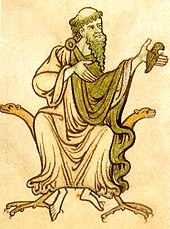Kevin from Glendalough
Kevin von Glendalough or Kevin von Wicklow or Kevin von den Engeln , old Irish Cóemgen , Irish Caoimhín , (* allegedly around 498 near Dublin ; † June 3, 618 in Glendalough ) is an Irish saint of the 6th and 7th centuries. Century. He is the patron saint of the Irish capital Dublin and the archdiocese of the same name . His feast day is June 3rd; but sometimes it is also celebrated on June 6th. Little is known about Kevin's life, as the oldest written records about him did not emerge until 500 to 600 years after his death.
Kevin was of the royal line. He is said to have worked miracles at an early age and an angel announced to his parents that their son would be "father of many monks" even before he was born, so they sent him to Kilnamanagh Monastery near Dublin for religious training. After a pilgrimage to Rome , he retired to Glendalough in County Wicklow . There he quickly found followers and founded the abbey around 549 on the upper of the two lakes of Glendalough , of which he was abbot until his death . There he instructed many people in the ascetic life . He himself lived mostly withdrawn in the forest and on the shore of the lake; the foundations of his "cell" in the forest ( Saint Kevin's Cell ) and the cave in which he supposedly slept ( Saint Kevin's Bed ) have been preserved to this day. It is unclear whether he was also a bishop . In any case, the subsequent abbots of his abbey were always also bishops of the diocese of Glendalough, which covered today's diocese of Dublin, which at that time was limited to the city of Dublin. The Diocese of Glendalough existed until the early 13th century.
The abbey quickly developed into a center of Christian life after Kevin's death and the large monastery town with a typical Irish round tower , the cathedral and the Saint Kevin's church developed near the lower lake . Most of the ruins in Glendalough that can still be visited today are believed to date from the 10th to 12th centuries and were built on the sites where simpler buildings made of wood and other materials stood in Kevin's day or in the years after his death. They were reconstructed in the course of the 19th century with the remaining original building material.
Kevin is also the patron saint of the blackbirds , with whom he is often portrayed, as he wanted a life in harmony with nature and was therefore allegedly often accompanied by birds. The patronage of blackbirds is based on the story that a blackbird is said to have laid an egg in his hand during Lent when Kevin prayed with outspread arms. Kevin then remained in the prayer position until the egg hatched and the young could fly away. He is said to have felt more comfortable with animals than with humans, and there are numerous stories about his dealings with animals.
Kevin allegedly died around 618 at the biblical age of 120. His grave quickly became the destination of numerous pilgrimages . Although attacked and destroyed by English troops in 1368, the monastery continued to exist until 1539, when it was dissolved by King Henry VIII of England , like all Catholic monasteries in the kingdom. In 1903 Kevin was canonized (cult confirmation).
Individual evidence
- ↑ St. Kevin of Glendalough on infoplease.com
- ^ Martyrologium Romanum 2004
- ↑ Michael Rodgers, Marcus Losack: Glendalough - A Celtic Pilgrimage . Columbia Press, Dublin 1996, ISBN 1-85607-173-1 . , P. 18
- ↑ Liam Prince: Glendalough - St Kevin's Road . In: Essays and Studies presented to Prof. Eoin Mitchell (Ed .: John Ryan), Dublin 1940. p. 261
- ↑ Mike Cronin: Irish History for Dummies. Wiley-VCH Verlag, 2009, ISBN 978-3-527-70506-1 , p. 82 ( online text on Google )
literature
- Lennox Barrow: Glendalough and Saint Kevin . Dundalgan Press, Dundalk 1972.
- Ailbhe Séamus Mac Shamhráin: The 'unity' of Cóemgen and Ciarán. A convent between Glendalough and Clonmacnoise in the tenth to eleventh centuries. In: Wicklow: history and society : interdisciplinary essays on the history of an Irish county, hrg. by Ken Hannigan and William Nolan. Geography Publications, Dublin 1994, pp. 139-50.
- Hugo Altmann: Kevin (Gaelic: Caemgen, Latin: Coemgenus, Caimginus, Keivinus). In: Biographisch-Bibliographisches Kirchenlexikon (BBKL). Volume 3, Bautz, Herzberg 1992, ISBN 3-88309-035-2 .
Web links
| personal data | |
|---|---|
| SURNAME | Kevin from Glendalough |
| ALTERNATIVE NAMES | Kevin from Wicklow; Kevin from the Angels |
| BRIEF DESCRIPTION | Irish saint |
| DATE OF BIRTH | at 498 |
| PLACE OF BIRTH | near Dublin |
| DATE OF DEATH | June 3, 618 |
| Place of death | Glendalough |

